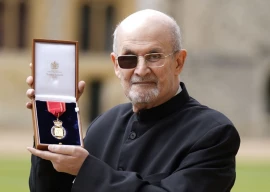PESHAWAR:
A rusting signboard inscribed with pottery in capital letters hangs aimlessly over a padlocked door in a narrow street of Shah Wali Qatal on the backside of the Qissa Khwani (storytellers) Bazaar. The street is empty, except for a carelessly parked Vespa scooter and a pushcart.
The street was once home to Peshawar’s finest pottery works, world famous for their white clay glazed earthenware. Now an eerie silence fills the once famous pottery street, which reverberates with tales of the past when it was visited by dignitaries every day. It now seems like a time from another age.
Peshawar pottery closed following the death of its owner, Abdul Rauf Seemab, in 2009, said Naveed, a cutlery dealer in the street. He said most of the shops in the area now deal in Chinese crockery.
“Seemab Saab was an old leaguer and received a gold medal for his efforts during the Pakistan Movement,” Naveed reminisced. He said that Seemab had no sons to carry on his legacy — after his death the workshop closed and now a plaza is being built in its place.
Khayal Mohammad, a labourer who worked for a long time in the street, added that Seemab also had hookahs in his shop that he brought from somewhere else. But the prized pottery he made himself. “Renowned personalities used to visit his workshop; many of them I saw myself.”
To reach Shah Wali Qatal one has to go into a narrow street, either from Qissa Khawni or Misgaran (Coppersmiths) Bazaar, which is on its eastern end.
Misgaran Bazaar itself is a shadow of its former self; the artisans who used to make bronze utensils have also called it a day and now sell stainless steel wares. The street also housed the forefathers of Indian filmstar Shahrukh Khan.
Mian Azizur Rehman, owner of the Ghalib Perfume Shop in one of the narrow lanes, is witness to the streets’ transitions. “Those who had the cure for heartaches will be remembered immensely after they are gone,” was the emotional outburst of the old seller as he quoted last Mughal emperor Bahadar Shah Zafar’s words.
He said Shah Wali Qatal’s prominent personalities “have fallen” and now it is an altogether different time. Going back in time he related the turbulent politics of the 1930s, when Peshawar was simmering with anti-British sentiments. Rehman’s father was arrested for killing an English civil surgeon Captain John Coldstream.
The troubled times are still reflected in the white marble arches of Yadgar Shahuda in Qisa Khawani Bazaar, where the British opened fire on the Red Shirts protesting against the arrest of Khudai Khidmatgar (servants of God) Chief Khan Abdul Ghaffar Khan.
Rehman drew a comparison of the streets’ situation with 19th century novel “The Last Days of Pompeii”.
“We talk about the past as there is nothing else left.” He said Shah Wali Qatal and Misgaran Bazaar were visited by Abdul Ghaffar Khan, the Duke of Edinburgh, Queen Elizabeth, and Farah Diba of Iran in Ayub’s period - unsurprising as the place was a popular tourist attraction.
The Tourists Information Catalogue prepared by the tourism department mentions products of “Peshawar Pottery” as a source of attraction. In an interview with APP before his death, Seemab said that the art of the store was different from ordinary pottery due to the quality materials used.
“The standard of crockery made at Peshawar Pottery was equivalent to the craftsmanship in England,” Sehrai Travel and Tours Managing Director Zahoor Durrani said. The workers of craftsmen and potters on display required due attention from the government as well as private agencies, for its preservation of a rich cultural heritage, he added.
Some claim the name Peshawar to be a derivation from Pesha-war meaning artisans. It is no exaggeration as for a long time the city has been known for its silversmiths, karakuli cap makers, pottery and wood engravers. Although for people like Azizur Rehman Ghalib, who lived through these times, only nostalgia fills the once vibrant streets.
*With additional input from APP
Published in The Express Tribune, November 19th, 2011.
COMMENTS (1)
Comments are moderated and generally will be posted if they are on-topic and not abusive.
For more information, please see our Comments FAQ










































Pottery work is still existing in Peshawar and in surrounding areas.Potters exhibit their work on Ashoora, as they use to set an ordinary bazaar, nearby the graveyard on Hazarkhani Road, out side of Ganj Gate and also on out side of Yakatoot Gate Peshawar. But the glazed pottery work decorated in the Show Room of Shahwali Qatal has been folded. It was really a source of attraction for foreigners and also for visiting dignities of Peshawar and Abdur Rauf Seemab was the master.